How can old-fashioned card decks help makers build a better immersive experience?
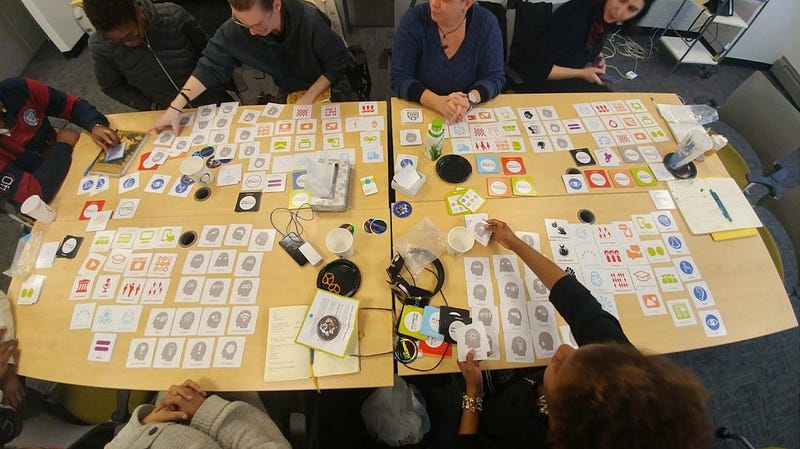 Playing with the Impact Pack at PhillyCAM
Playing with the Impact Pack at PhillyCAMThe theme for this issue of Immerse is “playing with reality.” As we’ve been assembling it, I’ve been thinking about how working on the publication inspired me to create my own game—and how that in turn opened my eyes to an entire genre of card games designed to inform real-world media strategy.
Over the past five years, I’ve collaborated with Carrie McLaren—who is also part of the Immerse editorial collective—to create and evolve a strategy deck called the Impact Pack. The deck is designed to help media makers, funders, and producers map out a project or campaign, with an eye towards understanding different models for engaging audience members and generating social impact. In funder jargon, we call it a “theory of change builder” — it allows players to think through which platforms they’re using, who they are targeting, how they will engage stakeholders, and what the outcomes might be.
Initially, these were all positive outcomes, a hopeful formulation: behavior change, political change, empowerment, increased trust. But last year we added a new suit: “Unintended Outcomes.” This allows players to contemplate how even their best intentions might go awry, spurring addiction, narcissism, bullying, depression, and more. This seemed especially crucial in an era of social media and misinformation
The deck can be used for project planning up front or mid-stream, for evaluating an existing project, or just to unstick your brain and noodle with possibilities. We update it regularly to reflect the changing landscape of media platforms and issues. There’s a suit called “Senses” that’s designed especially for makers who are pushing the boundaries of experiential media. In addition to sight, sound, taste, smell, and touch, users can choose to incorporate a card called “the sixth sense,” and riff on what that might be: a sense of humor, a sense of the body in space, a sense of urgency.
Over the years, the deck has travelled around the globe to festivals, classrooms, and media outlets—Greenpeace International adopted it for their digital trainings, the Solutions Journalism Network took it to sessions in Africa and Latin America, policymakers in Budapest used it to think through media development for different countries. Users love the tactile experience of the physical deck, the meditative act of laying out a strategy step-by-step, and thinking through the arc of a project. But when the pandemic hit, our printer went dark for awhile, and we could no longer host in-person workshops. So we created a digital version, which has also proven to be useful for our clients and in educational settings. Drop us a line if you’d like to try it out.
 Our new
digital version of the Impact Pack
Our new
digital version of the Impact Pack
Pick a deck, any deck
In the course of developing the Impact Pack, we’ve discovered the unexpectedly bustling world of strategy decks for creative professionals. There are decks for dreaming up startups, planning thoughtful convenings, mapping out web site structure, surviving design projects, and many more.
Here are just a few of the decks I’ve collected over the years that are designed for storytellers, designers, and journalists. Some are still available, some have gone dark—like the media industry itself, the marketplace for these card games is tenuous and ever-changing.
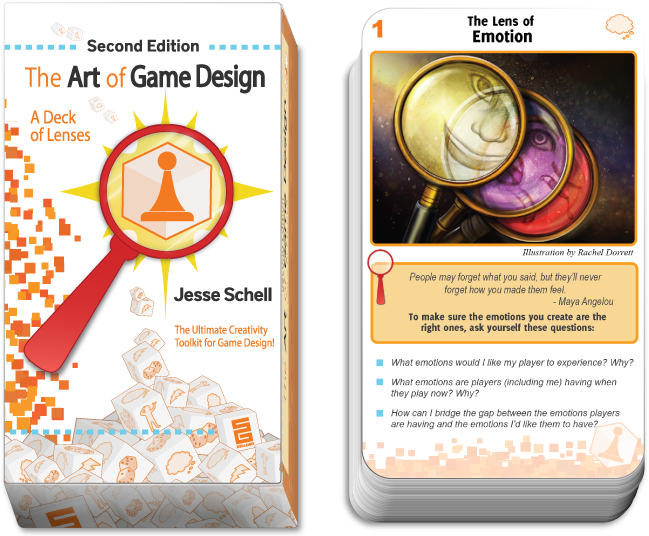
The Art of Game Design
What better way is there to learn how to create a game than to play one? This deck, designed by Jesse Schell—a professor at Carnegie Mellon’s Entertainment Technology Center and the CEO of Schell Games—offers players various “lenses” through which they can understand different aspects of game design. There are cards addressing mechanics, aesthetics, psychology, play-testing, and business. Each one includes a key principle and related questions. A companion book provides guidance on developing games for VR and AR.
Bonus: Just getting started in game design? Check out Grow-A-Game: Apprentice Edition.
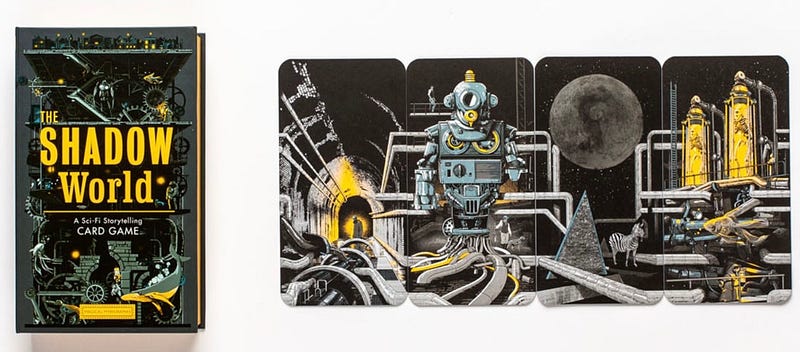
The Shadow World
This intriguing game for storyscaping science fiction narratives is illustrated by Shan Jiang, who also co-designs these amazing scarves. Entirely visual, it is based on Victorian card games called “myrioramas” that allow players to lay out cleverly interconnecting illustrations in any order to build a visual narrative. In this deck a set of adjoining tubes lead players through underground and underwater tunnels, labs, and lairs, featuring monsters, robots, adventurers, and — for some reason—a zebra lit by a full moon. Players can lay out their own stories, work together to create joint narratives, or create dueling tales. I found the game mechanics fascinating, but for me it also brought up the limitations of the genre: while the male characters get to be scientists, explorers, and bounty hunters, female characters include “the wife-bot” and “the witch.”
Bonus: Explore similar games from the same publisher: The Mystery Mansion and The Hollow Woods.
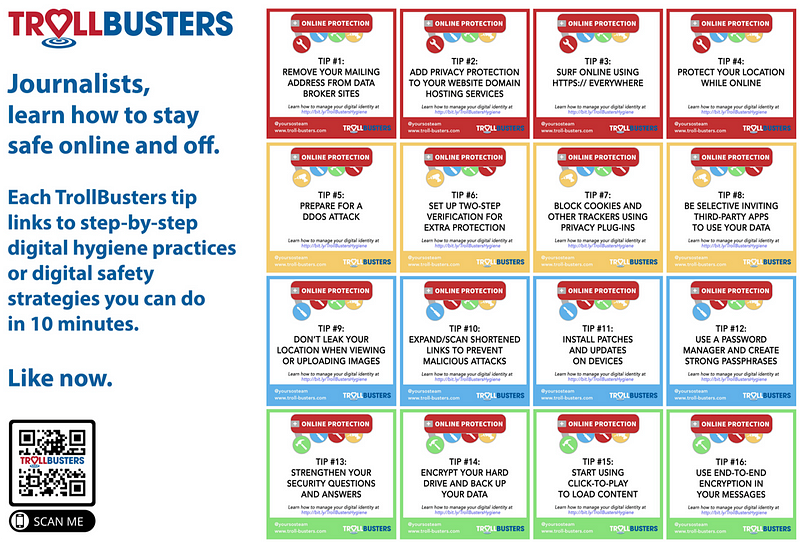
The Digital Hygiene Care Pack Cards
Designed by TrollBusters—an organization dedicated to supporting female journalists who are experiencing digital harassment or threats of violence—this deck offers tips on staying safe and how to respond to attacks (or not), and reflections on how to cultivate resilience. TrollBusters was founded by Michelle Ferrier, currently a professor at the School of Journalism and Graphic Communication at Florida Agricultural and Mechanical University. She began the project in response to her own experience of receiving hate mail as a local newspaper columnist.
Bonus: Want to think further about how to deal with trolls? See Cards Against Community.
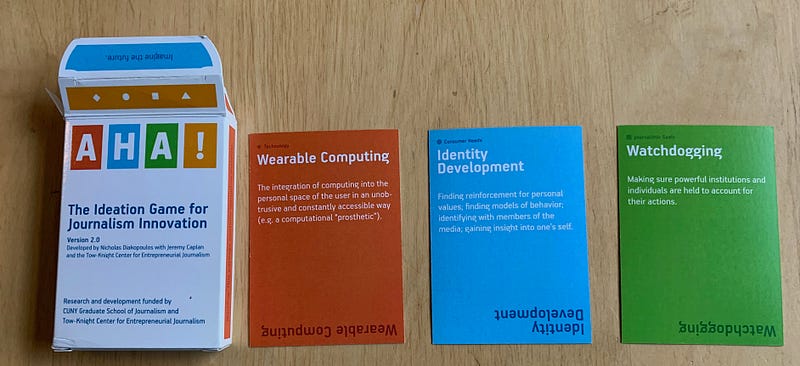
Aha! The Ideation Game for Journalism Innovation
Nicholas Diakopoulos — now an associate professor at Northwestern’s School of Communication, where he directs the Computational Journalism Lab — designed this deck. It emerged from a research project that he conducted for CUNY’s Tow-Knight Center for Entrepreneurial Journalism. The deck is divided into three color-coded suits: “Technology,” “Consumer Needs,” and “Journalistic Goals.” Players get one card from each suit, and then are challenged to invent a journalistic product or service and a related use case. After a few rounds, they present their best idea to the larger group. This deck was last updated in 2016 and looks to have gone out of circulation. To get a sense of how it worked in practice, see this post from two journalism students at Cal Poly.
Bonus: Looking for another game to use in your classroom? Check out the Journalism + Design Cards from The New School.
ORA+CLE Divination for Designers [& Others]
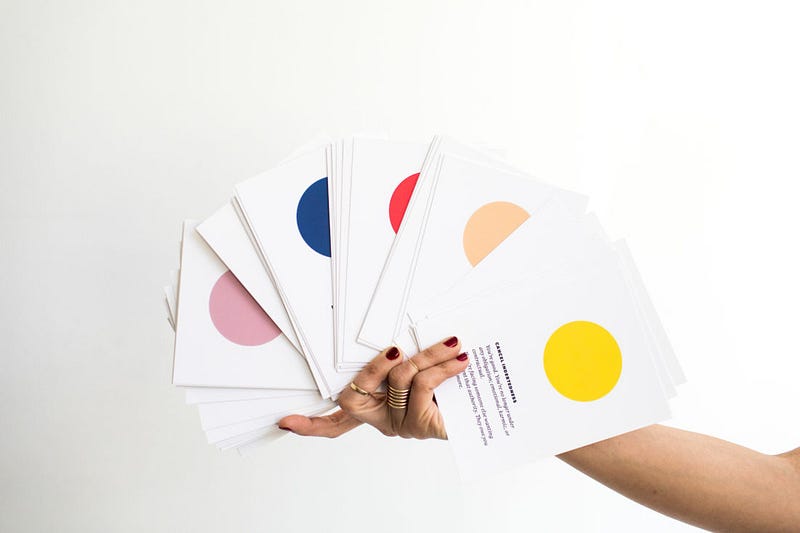
For a more contemplative experience, this deck offers users the chance to select a card or lay out a spread in order to meditate upon the relationship between designer and client. Each of the 50 cards is marked with a colored dot, and contains an insight (examples: “Embody Ouroboros” or “Utilize Hyperbole” ) along with related instructions for finding meaning.
The deck is part of a larger set of projects by designer Jennifer Eisner, who rather hilariously explains:
“My artist practice is a critique of my professional practice. It’s a decades-long performance piece. ORA+CLE is the most recent in a series of projects titled: The Cantos. A reckoning of past work, behaviors, and clients. The Cantos: 1 was a 2-month long, daily written response to a 6,000 mile journey on a 40′ scroll. The Cantos: 2 was the burning of this scroll and the ashes used to bake a cake I ate. The Cantos: 3 was a month-long, live-streamed reading of 2,000 pages of email, representing nine months of digital communication — from the initial courting through the final threat of a lawsuit. ORA+CLE is The Cantos: 4. And The Cantos: 5 will be a future performance where I’ll ritualistically strangle a client’s emails with zip cords.”
Bonus: Seeking more design inspiration? Take a look at Ideo’s Method Cards.
For more news, discourse, and resources on immersive and emerging forms of nonfiction media, sign up for our monthly newsletter.
Immerse is an initiative of the MIT Open DocLab and receives funding from Just Films | Ford Foundation and the MacArthur Foundation. The Gotham Film & Media Institute is our fiscal sponsor. Learn more here. We are committed to exploring and showcasing emerging nonfiction projects that push the boundaries of media and tackle issues of social justice — and rely on friends like you to sustain ourselves and grow. Join us by making a gift today.